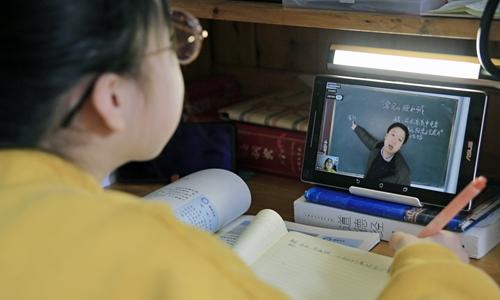Coronavirus Challenges in the Interconnected Health and Education Sectors
archive


A worker disinfects a school in the Ipekyolu district of Turkey's eastern Van province, March 2020 (IHA Photo)
Coronavirus Challenges in the Interconnected Health and Education Sectors
The potential collapse of multilateralism and globalization has recently intensified as the coronavirus pushes political isolationism even further. Due to the corona pandemic of 2020, governments closed their borders and undermined the free movement of people. All means of transportation between countries were cut back overnight—no transportation by air, no transportation by sea nor by land. In only a matter of weeks, people were locked into their cities, regions, states, and countries. We have to accept that this dangerous virus continues to rage—but for how long? One year? Two years? And what should we do in the meantime?
While waiting for the development of a vaccine we must seize the opportunity to rethink in what kind of future interconnected world we want to live. Benedikter and Kofler contend that we should do so by systematically reflecting on six important dimensions of globalization: economy, politics, culture, religion/spirituality, demography, and technology. The trends indicated in their outline turn out to be consistent and have been accelerated. Yet, curiously, it appears that two dimensions are missing: education and health.
Education
The education sector was little prepared for such a crisis. From one day to the next, several countries closed all institutions of education, which caused a systemic shock: In early April, in approximately 150 countries,1 nursery schools, primary and secondary schools, and institutions of higher education were forced to shut down. Politicians challenged parents and teachers and asked for home schooling and online teaching. Parents heard confusing messages regarding the timing of the closures. The weakness of national governance structures in education became apparent: who makes the decision for closure and for re-opening of the institutions of education?
In the future do we need a protocol for the education sector which recommends the necessary actions in a crisis, and could such protocol be drafted with international partners, for instance under the auspices of UNESCO or OECD?
Endless discussions on all levels of national governance structures irritate parents. “Home schooling is hard even for the best of us,” comment the editors in the Financial Times.2 An enforced measure obliges parents to master not only their own professional life during the crisis but to rescue their child’s education as well. Disadvantaged families find themselves, again, in a difficult situation as it is not only the intellectual challenge but also the still prevalent technological gap that creates new inequity in our societies.
On-line education seems in theory a good alternative when schools have to shut down due to a crisis, but the question arises as to whether our schools and households are well enough equipped to rise to the challenge. School facilities and teacher knowhow differ significantly among countries but also among regions and even more so among residential areas.
In 2018, the global PISA (Program for International Student Assessment) collected data about students’ access to the digital world:3 in Austria, Denmark, Iceland, Lithuania, the Netherlands, Norway, Poland, and Switzerland, over 95% of students report that they have a computer to use for working at home. But there tend to be very large gaps across socio-economic groups. For example, every 15-year-old in socio-economically advantaged schools in the United States has a computer to work with at home, but only three out of four students in disadvantaged schools have one.
Another issue is the access to internet required for online learning. There are countries where internet access at home is close to universal, while in others it reaches just half of 15-year-olds. A representative of the UK Ministry for education reported on April 19 that close to 400,000 secondary school students live in homes without internet access.4 Consequently, the digital divide is amplified in times of crisis.

A student takes an online course at home in China's Shanxi Province during the coronavirus outbreak.
(Photo: IC)
Even in homes with access, many suffer from slow connections and other technological limitations. According to PISA, little more than two-thirds of 15-year-old students are enrolled in schools whose principal reported that the digital devices at school are sufficiently powerful in terms of computing capacity; in Japan it is less than half, and in Kosovo just one in five. The internet bandwidth of schools also varies among countries and states; while principals from some provinces in China report that their capacity is sufficient, in Colombia, Germany, Portugal and Mexico this is the case for less than one third.
In education, global venture capital investment has increased significantly over the past few years, going from USD 1.8 billion to 8.2 billion between 2014 and 2018.5 China has surpassed the US as the main investor, and 50% of the global venture market in 2018 came from China. The US, even though it increased its investment, contributed only 20% that same year. India has also increased its investment, spending USD 700 million in 2018 on the development of innovative solutions for education, more than the European Union (500 million USD). Chinese families invest more in education than any other nationality, allowing China to develop as the world’s largest digital market with 172 million online learners. Public and private partnerships are accepted.
In China, where public-private partnerships are acceptable, the company Alibaba has taken over many tasks of the public education sector, providing the platform ‘Dingtalk’ where schools and universities record their curricula. In March 2020, about 50 million primary and secondary school students and 600,000 teachers are supposed to have used the app.6
The corona crisis will contribute to the success of the digital education market; more competition around the globe for this innovative sector is needed.
International collaboration and exchange of online educational resources are important. While countries have different curricula, educators nevertheless teach similar subjects and could translate some existing online courses from other parts of the world and adapt them to the specificity of their country or region.
There are countries where internet access at home is close to universal, while in others it reaches just half of 15-year-olds.
We should not forget, however: without well-trained teachers who communicate well with students and parents, the digital techniques will show only limited success. The Financial Times editorial ends with a prophetic conclusion: “Teachers will never have to prove that they are worth it.”7 Indeed, only after a few weeks of schools being closed, parents have voiced in print and in social media their increased respect for teachers!
In the domain of higher education, the situation is more complex. The responsibilities of an institution of higher education extends to national and increasingly to international students. In general, universities are well equipped with digital communications and many have leveraged these technologies to build MOOCS and learning platforms.
Despite many successful digital ventures in higher education, tough restrictions on mobility will have consequences and the internationalization of higher education will suffer serious setbacks.
International students have been unable to travel to their campuses or to return home. Study abroad programs have been cancelled. The near future for the international higher education world looks grim. There is the financial side too. Universities in Australia, and a number of institutions in the US and in the UK, have become dependent on international student tuition fees as core revenue source. The major concern is a fall back into isolationism and the disruption of fruitful international networks. It must furthermore be firmly asserted that digital communication and digital learning can by no means replace the personal exchange of students and of professors.
Health and Education
As for the specific health related crisis, pertinent questions arise: How much cooperation exists between education and health systems?
In February 2010 the Education Directorate of the OECD convened a meeting of 70 education and health officials from 20 countries. It was surprising if not shocking to realize how little exchange—if any—had taken place between the two respective sectors prior to this conference. The two-day meeting resulted in a strong appeal to continue the exchange of knowledge and experiences between the two sectors on a national and international scale. There is little evidence that this appeal has borne fruit.
[D]igital communication and digital learning can by no means replace the personal exchange of students and of professors.
Yet in light of the COVID-19 pandemic, such exchanges appear ever more important as we address a host of pressing concerns: Which age groups should start to re-enter schools? Which hygienic measures are important? What are best practices for teaching and nurturing students under such conditions? We need to tackle these issues on a global basis—countries must exchange their experiences and learn from each other.
In conclusion, no single country can claim they are immune against the coronavirus and that they alone have mastered the systemic shock to the education sector. International organizations have been slow to respond to the challenges of the pandemic and advice in educational matters is insufficient. Two issues are of paramount importance: for one, we have to address the equity challenge in education as we develop exit strategies from this lockdown, paying particular attention to the needs of disadvantaged families. And second, past achievements in internationalization have to be rescued because they represent the foundational capital for better functioning multilateral organizations. Both the epidemic itself and the resulting educational crisis are global problems. They can be solved effectively only by global cooperation and strongly redefined international organizations.
1. Andreas Schleicher, “Education disrupted – education rebuilt: some insights from PISA on the availability and use of digital tools for learning”, OECD Education and Skills Today, April 1, 2020. https://oecdedutoday.com/coronavirus-education-digital-tools-for-learning/
2. Editorial, “Home schooling is hard even for the best of us”, Financial Times, March 28/29, 2020, p.10.
3. See note 1.
4. Interview with representative of UK Education Ministry, BBC World News, April 19, 2020.
5. Stephan Vincent-Lancrin, “Coronavirus and the future of Learning: Towards a new Ed Tech industry?”, OECD Education and Skills Today, April 14, 2020. https://oecdedutoday.com/coronavirus-future-learning-new-edtech-industry...
6. Gabor Steingart, “Das Morning Briefing,” April 8, 2020.
https://news.gaborsteingart.com/online.php?u=QupsdFe4174
7. See note 2.



